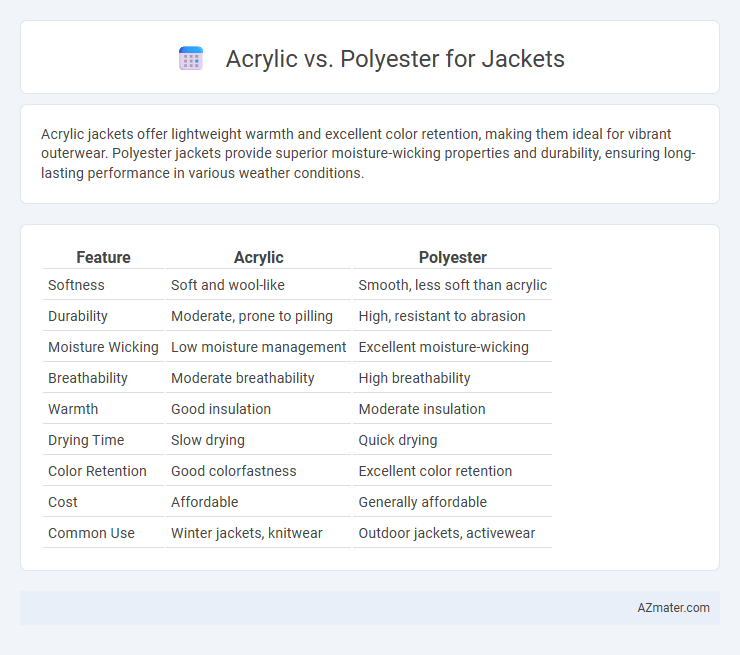Acrylic jackets offer lightweight warmth and excellent color retention, making them ideal for vibrant outerwear. Polyester jackets provide superior moisture-wicking properties and durability, ensuring long-lasting performance in various weather conditions.
Table of Comparison
| Feature | Acrylic | Polyester |
|---|---|---|
| Softness | Soft and wool-like | Smooth, less soft than acrylic |
| Durability | Moderate, prone to pilling | High, resistant to abrasion |
| Moisture Wicking | Low moisture management | Excellent moisture-wicking |
| Breathability | Moderate breathability | High breathability |
| Warmth | Good insulation | Moderate insulation |
| Drying Time | Slow drying | Quick drying |
| Color Retention | Good colorfastness | Excellent color retention |
| Cost | Affordable | Generally affordable |
| Common Use | Winter jackets, knitwear | Outdoor jackets, activewear |
Introduction to Acrylic and Polyester Fabrics
Acrylic fabric, known for its wool-like feel and lightweight warmth, is a synthetic material made from polymer fibers that offer excellent color retention and resistance to sunlight and mildew, making it ideal for jackets. Polyester, another synthetic fabric, is prized for its durability, moisture-wicking properties, and quick-drying capabilities, providing superior performance in outdoor and active wear jackets. Both fabrics are popular choices in jacket manufacturing due to their affordability, ease of care, and versatility across various weather conditions.
Key Differences Between Acrylic and Polyester
Acrylic jackets offer a soft, wool-like feel with better moisture-wicking properties, making them ideal for insulation and comfort in cooler weather. Polyester jackets provide superior durability, wrinkle resistance, and faster drying times due to their synthetic fibers, which excel in active wear and water-resistant outerwear. The key difference lies in acrylic's natural wool mimicry and polyester's high-performance synthetic benefits, influencing jacket choice based on usage and weather conditions.
Durability Comparison: Acrylic vs Polyester
Polyester jackets offer superior durability compared to acrylic due to their resistance to abrasion, stretching, and shrinking, making them ideal for long-term wear. Acrylic fibers tend to pill and lose shape more quickly under regular use, reducing the jacket's lifespan. Polyester's robust synthetic composition maintains color retention and structural integrity even after multiple washes, ensuring sustained performance over time.
Warmth and Insulation Properties
Acrylic jackets provide excellent warmth by mimicking wool's insulating properties, trapping heat effectively while remaining lightweight and moisture-resistant. Polyester jackets excel in insulation due to their ability to retain heat even when damp, making them suitable for wet conditions and high-activity use. Both fabrics offer durability, but polyester typically outperforms acrylic in moisture management and long-term thermal retention.
Moisture Resistance and Breathability
Acrylic jackets offer moderate moisture resistance but generally lack the breathability of polyester, making them less effective at wicking away sweat during intense activities. Polyester excels in moisture management with high water resistance and superior breathability, allowing for better airflow and faster drying times. Choosing polyester for jackets ensures enhanced comfort in wet or active environments by effectively balancing moisture control and ventilation.
Comfort and Texture Analysis
Acrylic jackets offer a soft, wool-like texture that provides warmth and breathability, making them comfortable for extended wear. Polyester jackets, known for their smooth, lightweight, and durable fabric, excel in moisture-wicking and quick-drying properties, enhancing comfort during active use. While acrylic tends to feel warmer and cozier, polyester delivers superior resilience and flexibility against wear and environmental factors.
Maintenance and Care Requirements
Acrylic jackets require gentle washing with cold water to prevent fiber damage and color fading, often needing air drying to maintain shape and softness. Polyester jackets offer superior durability, allowing machine washing with mild detergents and quick drying without shrinking or wrinkling. Both fabrics benefit from avoiding high heat ironing, but polyester's resistance to stains and moisture makes it lower maintenance compared to acrylic.
Environmental Impact of Acrylic and Polyester
Acrylic jackets contribute to microplastic pollution due to synthetic fiber shedding during washing, significantly impacting marine ecosystems. Polyester production consumes less water than natural fibers but relies heavily on petroleum, resulting in high carbon emissions and energy use. Both materials pose environmental challenges, though polyester recycling initiatives are increasing to reduce waste and resource consumption.
Cost Comparison and Affordability
Acrylic jackets typically cost less than polyester options due to lower production expenses and fiber sourcing. Polyester jackets, while slightly more expensive, offer better durability and moisture-wicking properties, which can justify the higher price in terms of value. Budget-conscious buyers seeking affordable warmth often favor acrylic for its cost efficiency, whereas those prioritizing longevity might invest in polyester despite the higher initial expense.
Choosing the Best Fabric for Your Jacket
Acrylic offers lightweight warmth and soft texture, making it ideal for casual jackets with good color retention and easy care. Polyester excels in durability, moisture-wicking, and resistance to wrinkles and shrinking, perfect for activewear and performance jackets. Selecting the best fabric depends on your jacket's intended use, desired comfort level, and maintenance preferences, with acrylic favored for softness and polyester for longevity and functionality.

Infographic: Acrylic vs Polyester for Jacket
 azmater.com
azmater.com